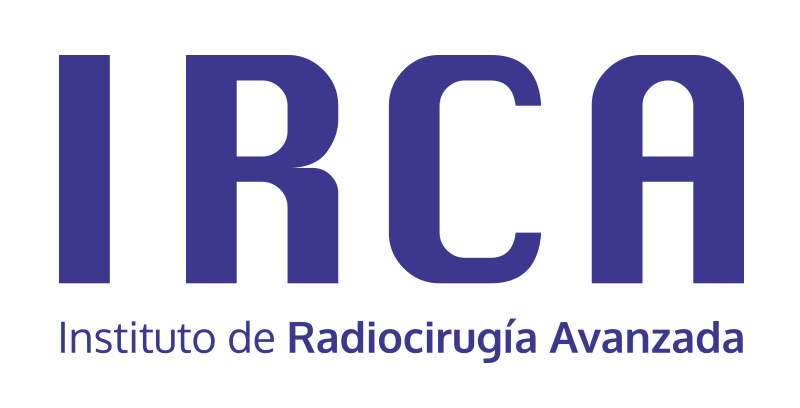SUCCESS CASES
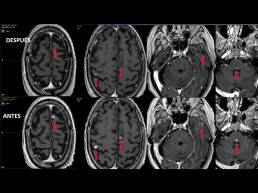
- Home
- SUCCESS CASES
MULTIPLE METASTASIS
OBJECTIVE
TUMOUR CONTROL AND QUALITY OF LIFE
66-year-old patient, diagnosed with lung cancer. Good initial response to chemotherapy but disease progression after exclusive treatment with immunotherapy. The patient is in good general condition and does sport every day. In a routine check-up he was diagnosed in October 2022 with 6 small brain metastases. At his referral centre he is offered palliative treatment with total brain irradiation.
He came to our centre for a second opinion and we recommended, following international protocols, radiosurgery with radical intent for all 6 lesions, in a single session. We have administered an effective dose at 6 sessions with sub-millimetric precision, preserving the healthy brain in such a way that the average dose received is 30 times lower than a total brain treatment, which not only drastically reduces the toxic effects of the radiation, but also makes new treatments possible, in a harmless way, if necessary.
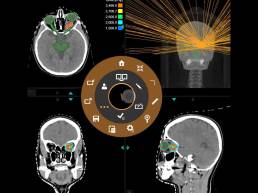
OPTIC NERVE MENINGIOMA
OBJECTIVE
TUMOUR CONTROL AND SAVE THE OPTIC N. OPTICO
A 39-year-old woman who came to our centre to assess radiosurgery for a meningioma of the left optic nerve diagnosed as a result of discomfort in this eye. As surgery was not possible, due to the risk of loss of vision, she was kept under observation and the lesion was observed to be progressing with protrusion of the eyeball out of the orbit.
He came to our centre and we proposed radiosurgery in 5 sessions, with the aim of giving an effective dose to the tumour, preserving the function of the optic nerve.
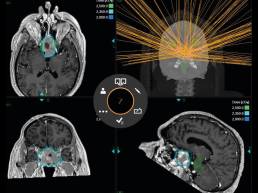
HYPOPHYSIS MACROADENOME
LARGEST TUMOUR TREATED WITH ZAP X RADIOSURGERY
WE PRESERVE THE OPTIC VIA
72 year old patient diagnosed with pituitary adenoma in 2006, due to decreased visual acuity. He has undergone 3 operations with partial resections and progression after all the operations.
The patient consulted due to progression of the visual deficit and a very large tumour was observed which completely displaced the optic nerves. We proposed treatment by radiosurgery in 5 fractions, managing to administer a therapeutic dose to the tumour while protecting the optic pathway so as not to worsen the visual deficit.
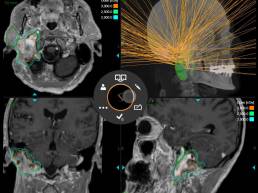
SOLITARY FIBROUS TUMOUR
OBJECTIVE
TUMOUR CONTROL AND LITTLE TOXICITY
66 year old patient who in 2009 debuted with facial paralysis and started a study. After suspicion of glomus jugulare tumour, he was referred for single-dose radiosurgery with a good initial response.
In 2018 he started again with facial spasms and was diagnosed with progression. He received a second single-dose radiosurgery treatment.
Subsequently, the facial paralysis progressed and surgery was performed in September 2022, diagnosing a solitary fibrous tumour.
Due to the persistence of a significant tumour residue, she consulted for a third irradiation. Given that the risk of injury to the carotid artery, which is attached to the tumour, is high, we decided to carry out treatment by radiosurgery in 5 sessions with dose control in this artery.
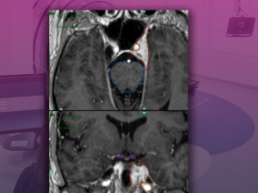
RECIDIVE IN CAVERNUS SINUS OF NASOPHARYNGEAL CARCINOMA
OBJECTIVE
TUMOUR CONTROL AND LOW TOXICITY
The arrival of ZAP – X in the world of radiosurgery has meant great advances in the treatment of head, neck and brain diseases, neck and brain. At IRCA, we combine this innovative technology with a prestigious medical team to achieve the best treatments for our patients. Thus, we can boast of having obtained great results during this time. Today we would like to tell you some details about how we treated a recurrence in the cavernous sinus of nasopharyngeal carcinoma.
